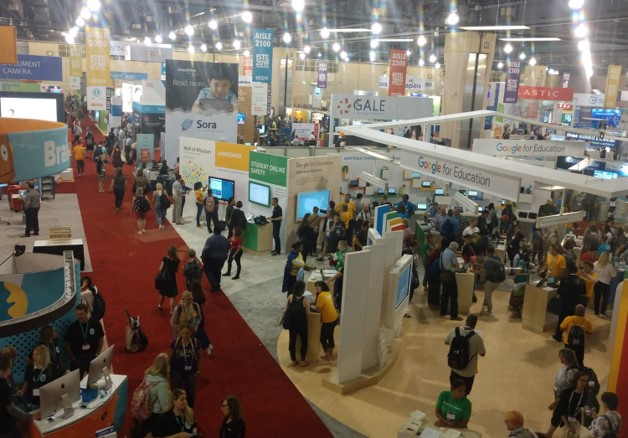Preparing for an artificial-intelligence future, nurturing inclusivity and amplifying student voice were among the hot topics of conversation in sessions and on the exhibit floor of this year’s International Society for Technology in Education conference in Philadelphia.
And SmartBrief was there. Here are highlights from days one and two of the event.
On the Mainstage Sunday
Pedro Rivera, Secretary of Education in Pennsylvania, welcomed ISTE attendees to Philadelphia, sharing a video about the state’s commitment to increasing access to STEM learning, an area of job demand in Pennsylvania.
Rivera shared his own experience as a middle school teacher more than 25 years ago when he and colleagues assembled their own desktop computers from leftover parts — saving the then-vast amounts of data onto floppy discs.
Cheyenne Batista was next and she spoke about having the difficult conversations in classrooms about inclusivity and about how her own background has prepared her to advocate for those who need it. Batista is the CEO of Firefly Worldwide Inc., a consulting firm that helps build leaders in nonprofit, government, corporate and education sectors. Her message to educators and students was clear: You have a voice, it will be heard.
Danielle Feinberg, director of photography for lighting at Pixar, took the mainstage to talk about her own early interest in computer science and how it eventually took her to Harvard. Feinberg shared about how seeing women in teaching roles for computer science made her more confident in picking it as a career for herself. Feinberg pulled back the Hollywood curtain to reveal how one of the most iconic scenes in the Pixar film Coco was made.
Futurist and author Mike Walsh was the final speaker of the night and he discussed the dawning of the “Algorithmic Age,” or a time period when things seamlessly work on intuition or past habits or current behaviors. He noted that at some point, humans won’t be able to tell where they end and technology begins.
Monday sessions we loved
ISTE Press Briefing: Members of the media got a sneak peek at the four main focuses of the conference — and what to expect to see more from on the horizon. ISTE CEO Richard Culatta gave a brief overview and each topic was grounded in examples from ISTE educators on a media panel. The four areas of focus include readying students for an artificial intelligence future, continuing the Ted Talk program for educators, digital citizenship and what it means to be not just safe but a contributing member of the online world; and an increased commitment to equity in classrooms, schools, districts and an entire education industry.
Amplifying Student Voice With Technology: Diverse Approaches From Diverse Districts: This poster session from Vincent Green and Marie Henderson discussed a student-centered learning template to help give students more of a voice — and give that voice more dynamics, with emphasis on more than one path to success.
NASA Makerspace Playground: The Sky is Not the Limit!: Attendees experienced an immersive NASA makerspace that demonstrated how to incorporate NASA content into STEM learning activities. Virtual reality, NASA 3D prints and even using a smartphone to make meaningful scientific measurements were part of the experience.
AI in the Hands of your Students: Presented by computer science educator Doug Bergman and Amazon Web Services’ David Parmele, this session looked at the power of artificial intelligence to transform real life objects, like airplanes or plants, and even to recognize actions. The deep-learning enabled AWS DeepLens was included in the presentation.
Can Everyone Code? Preparing Teachers to Teach Computer Languages as a Literacy: The presentation of this research paper looked at how the convenience of mobile devices can boost opportunities to learn and teach coding. The research made use of the Everyone Can Code curriculum and the Swift Playgrounds app on iPad to teach educators the programming skills they’ll need to teach coding effectively.
Building Collaborative Content with Podcasts: This poster session looked at the EdTech PodSquad that consists of five technology coaches from throughout Missouri and how they use collaborative tools like Docs, Twitter, Slides and Zoom to build content beyond the classroom.
What are you seeing at ISTE? Tell us about what you’re learning or conversations you’re having with your peers. Follow us on Twitter and share your thoughts. Then come back tomorrow for more insights from ISTE19!
Katie Parsons edits SmartBrief newsletters on EdTech and Math Education. She has a background in news media, working at the Orlando Sentinel and Chicago Tribune as a researcher and reporter. She is the creator of the parenting blog Mumbling Mommy and her writing has appeared in 150+ online and in-print publications, including the Huffington Post, USA Today, GalTime, ChamberofCommerce.com and Florida Today. She is the co-author of The Five Year Journal, available on Amazon. Contact Katie at katie.parsons@futurenet.com.
___________________________________________________________________________
Like this article? Sign up for SmartBrief on EdTech to get news like this in your inbox, or check out all of SmartBrief’s education newsletters , covering career and technical education, educational leadership, math education and more.
